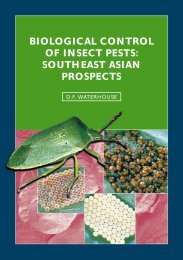Adobe PDF - EcoPort
Adobe PDF - EcoPort
Adobe PDF - EcoPort
You also want an ePaper? Increase the reach of your titles
YUMPU automatically turns print PDFs into web optimized ePapers that Google loves.
54<br />
1:0, 1:1, 1:2, 1:3 and 1:4 of C. argentea to A. spinosus. A distance<br />
of 6 cm was maintained between and among stands of combining<br />
species. In the field trial, the same treatment combinations<br />
were established but in a randomized complete block design<br />
with three replicates. Each block was 2 x 1 m 2 . The plots were<br />
bed-raised with hoes. The plots were 0.5m apart. Seeds of C.<br />
argentea were drilled at 15cm spacing between rows and later<br />
thinned to 15cm within rows to have a plant density of 444,444<br />
plants per hectare.. Seeds of A. spinosus were ring-broadcast<br />
at 6cm intervals and later thinned to the required density ratios<br />
at 2 WAP. The performance of both C. argentea and A. spinosus<br />
was monitored in terms of plant height, stem diameter, number<br />
of leaves/plant, leaf area and plant biomass at harvest.<br />
S. OGUNYEMI et al.<br />
Experiment II. Corchorus olitorius versus Amaranthus<br />
spinosus: The design of the experiment followed the two<br />
component model as described by Hall et al. (1992). The 1 st<br />
component is the maximum length of time weeds emerging<br />
with the crop can remain before they reduce yield (weedy and<br />
subsequently weedfree, wd-wf) and the 2 nd component is the<br />
length of time that a crop must be kept weed-free after planting<br />
so that weeds emerging later do not reduce yield (weedfree<br />
and subsequently weedy, wf-wd). A. spinosus was allowed to<br />
associate with C. olitorius for varying periods of time (as<br />
indicated in Table 1). The same treatments were established in<br />
pots and in the field. In the pots, two seeds of C. olitorius and<br />
4 of A. spinosus were sown in each pot to give a ratio of 1:2 crop<br />
to weed. Weed-crop distance was 8cm in all pots. The pot trial<br />
was a completely randomized design while the field was a<br />
randomized complete block design with 3 replicates. Each block<br />
was (12 x 2) m 2 and each plot was 2 x 1 m 2 . C. olitorious was<br />
planted in rows with 30cm inter-row spacing and later thinned<br />
to the required population densities. Seeds of A. spinosus were<br />
planted in rows 8cm from C. olitorious and a crop to weed ratio<br />
of 1:2 was also maintained. Data recorded for C. olitorius at 12<br />
weeks after planting (WAP) were plant height, stem diameter,<br />
number of leaves per plant and plant dry weight at harvest. All<br />
dry weights were obtained by oven drying harvested materials<br />
for 48 hours at 70 0 C before weighing. All data collected were<br />
subjected to ANOVA and mean differences were compared<br />
using DMRT at 5% level of probability (Gomez and Gomez,<br />
1983).<br />
Results<br />
Density and Duration of Interaction between A. spinosus and<br />
C. argentea. In the presentation of results the four control<br />
treatments were pooled into one treatment (D0). Different<br />
densities of A. spinosus growing in association with Celosia<br />
argentea exerted significant pressure on the performance of<br />
the potherb. In the pot trial, regardless of duration of weed<br />
association, density presssure caused significant reduction in<br />
the stem height and the number of leaves per plant of Celosia<br />
argentea (Table 2). However, the treatments were not<br />
significantly different with regards to stem diameter. In the field<br />
trial, A. spinosus induced significant reduction in stem height,<br />
stem diameter and number of leaves per plant of Celosia<br />
argentea (Table 2). Dry matter production was also<br />
significantly reduced by increasing weed density regardless<br />
of duration of competition especially in the field trial, although<br />
fresh weight of Celosia a rgentea was not significantly affected<br />
by interference from A. spinosus (Table 3). It was informative<br />
that dry weight suffered as high as 50% reduction when four A.<br />
spinosus competed with one Celosia argentea for eight weeks.<br />
Critical period of interference of A. spinosus with Corchorus<br />
olitorius. In the two trials at 12 WAP the C. olitorius exposed<br />
to weedy treatment (Treatment 7) had significantly reduced<br />
height (Table 4). They were similar to plants that were weedy<br />
for at least four weeks (Treatments 3, 4, 5 & 6). The weedfree<br />
plants (Treatment 1) and those that were weedy in the first<br />
two weeks and subsequently weedfree (Treatment 2) had<br />
good height growth and were similar to those plants that<br />
were weedfree for at least two weeks (Treatments 8, 9, 10, 11<br />
& 12). The treatments followed the same trend in terms of all<br />
growth parameters considered. With regards to dry matter<br />
accumulation in the field trial, plants that were weedy for at<br />
least the first 2 weeks (Treatments 1 & 2) and those that<br />
were weedfree for at least the first four weeks (Treatments 9,<br />
10, 11 & 12) were similar and had significantly (P






